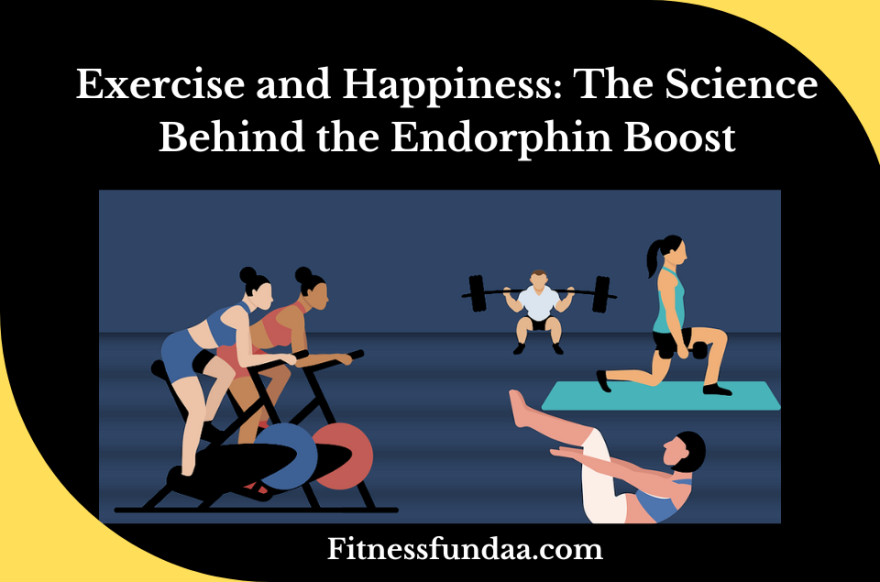The relationship between exercise and happiness is quite multifaceted. When a person is engaged in physical exercises, it leads to the release of endorphins, the brain’s “feel good” neurotransmitters which foster sensations of pleasure and euphoric feelings.
Doing exercises daily helps in regulating stress hormones such as cortisol, leading to reduced stress levels and a more balanced emotional state. Furthermore, it positively impacts neurotransmitter balance, which helps in alleviation and a calmer mental state.
Improved sleep quality, enhanced cognitive function, and positive effects on self-esteem and body image further underscore the significance of this relationship. Socially, exercise facilitates interaction and connection, while its long-term mental health benefits include a reduced risk of disorders and a proactive coping mechanism.
As a reward, exercise stimulates dopamine release, reinforcing positive feelings and promoting a sense of empowerment. Overall, the integration of regular physical activity into one’s routine plays a crucial role in fostering various aspects of life.
Endorphins and Exercise:
Endorphins, operating as neurotransmitters in the human body, serve a dual role within the central nervous system by functioning as innate pain mitigators and mood enhancers in the brain. These chemical messengers are naturally synthesized in response to stress and physical exertion, representing an inherent mechanism designed to alleviate discomfort and uplift one’s emotional state.
The liberation of endorphins is particularly triggered by engaging in various physical activities, such as aerobic exercises, running, or participating in intense workouts. This physiological response to stress or physical effort illustrates the body’s adaptive strategy for managing discomfort and regulating emotional well-being.
The dual functionality of endorphins, serving as natural pain mitigators and mood enhancers, underscores their critical role in promoting overall well-being and emphasizes the positive impact of physical activity on mental health in human form.
Mechanism of Endorphin Release:
When you exercise, your body goes through a fascinating process that involves the release of endorphins—those natural mood lifters and painkillers in your brain. Here’s a simple breakdown of what happens:
Get Those Neurons Going:
Inside your brain, there are neurons responsible for producing endorphins. When you face stress or put your body through physical activity, these neurons kick into gear.
Receptor Connection:
Endorphins interact with specific receptors in your brain and spinal cord called mu-opioid receptors. When these receptors get activated, it’s like turning down the volume on pain and turning up the feelings of pleasure and well-being.
- Exercise Favorites for Endorphins:
- Different exercises have different effects on endorphin release: Aerobic Activities (Running, Cycling, Dancing). These types of exercises, where you keep your heart rate up, are great for triggering a steady flow of endorphins, giving you that “runner’s high.”
- Strength Training (Weightlifting): Working your muscles through resistance training also activates endorphin-producing neurons, providing a natural pain-relieving effect.
- High-Intensity Interval Training (HIIT): Mixing intense bursts of activity with rest periods in HIIT workouts can significantly boost endorphin release.
How Long and How Hard Matters:
The duration and intensity of your workout make a difference. Longer sessions of moderate to intense exercise generally lead to more endorphin release. Even short but intense workouts, like those in HIIT, can pack a punch in the endorphin department
Improvements in Depression Symptoms- Exercise and Depression:
Studies highlight the link between exercise-induced endorphin release and improvements in depressive symptoms. Regular physical activity, known to increase endorphin levels, is recommended as a complementary approach in depression treatment.
Endorphin Levels and Depression Severity: Research suggests that individuals with depression may have lower baseline endorphin level.
Psychological Benefits:
When you weave exercise into your daily life, it does more than simply trigger a rush of endorphins. It’s like giving your overall well-being a VIP pass. Picture this: each workout becomes a personal triumph, boosting your self-esteem as you conquer fitness milestones. It’s not just about sculpting your physique; it’s about sculpting a positive self-image.
Your brain gets a workout too. Regular physical activity enhances your cognitive abilities – think improved learning, better memory, and sharper thinking. It’s like a full-body and mind tune-up.
Now, let’s talk about the beauty of sleep. Exercise becomes your natural sleep conductor, orchestrating better sleep patterns and ensuring you hit the snooze button with a contented sigh. And the stress? Consider it handled. Exercise plays the role of a stress maestro, conducting a symphony of hormonal balance and neurotransmitter release. Cortisol takes a backseat, while serotonin and dopamine take center stage, leaving you in a state of relaxation and calm.
What’s even more delightful is the social dance that comes with exercise. Whether you’re grooving in a group fitness class or hitting the pavement with a running buddy, it’s a social celebration.
In conclusion, incorporating regular exercise into your lifestyle transcends the immediate joy of endorphin release. It emerges as a multifaceted cornerstone for mental and emotional well-being, fostering heightened self-esteem through personal achievements, sharpening cognitive function, orchestrating better sleep patterns, and conducting a harmonious symphony of stress relief.
Moreover, the social dimension of exercise adds a layer of joy and connection to this holistic approach. Each workout is not merely a physical endeavor; it becomes a powerful investment in a healthier and happier you, touching every facet of your life. So, lace up those sneakers, embrace the movement, and let the transformative power of exercise unfold for a more vibrant and fulfilling existence.
FAQs Answered
What is the role of endorphins in exercise and happiness?
A1: Endorphins, acting as neurotransmitters, play a dual role as pain mitigators and mood enhancers. Engaging in physical activities triggers their release, fostering sensations of pleasure and euphoria.
How does exercise contribute to reducing stress and regulating emotional states?
A2: Regular exercise regulates stress hormones like cortisol, leading to reduced stress levels and a more balanced emotional state. It positively impacts neurotransmitter balance, promoting a calmer mental state.
What is the link between exercise, endorphins, and improvements in depression symptoms?
A3: Studies highlight a connection between exercise-induced endorphin release and improvements in depressive symptoms. Regular physical activity, known to increase endorphin levels, is recommended as a complementary approach in depression treatment.
Besides endorphin release, what are the psychological benefits of exercise?
A4: Exercise enhances self-esteem by achieving fitness goals, improves cognitive function, regulates sleep patterns, positively affects body image, and fosters social interaction and connection.
How does exercise impact sleep quality and stress relief?
A5: Exercise regulates circadian rhythms, contributing to better sleep quality. It acts as a stress maestro, balancing hormones and releasing neurotransmitters like serotonin and dopamine, promoting relaxation.
Is exercise only beneficial for physical health, or does it have broader implications?
A: Exercise goes beyond physical health; it is a multifaceted cornerstone for mental and emotional well-being. It touches on various aspects of life, including self-esteem, cognitive function, sleep patterns, and social connection.

